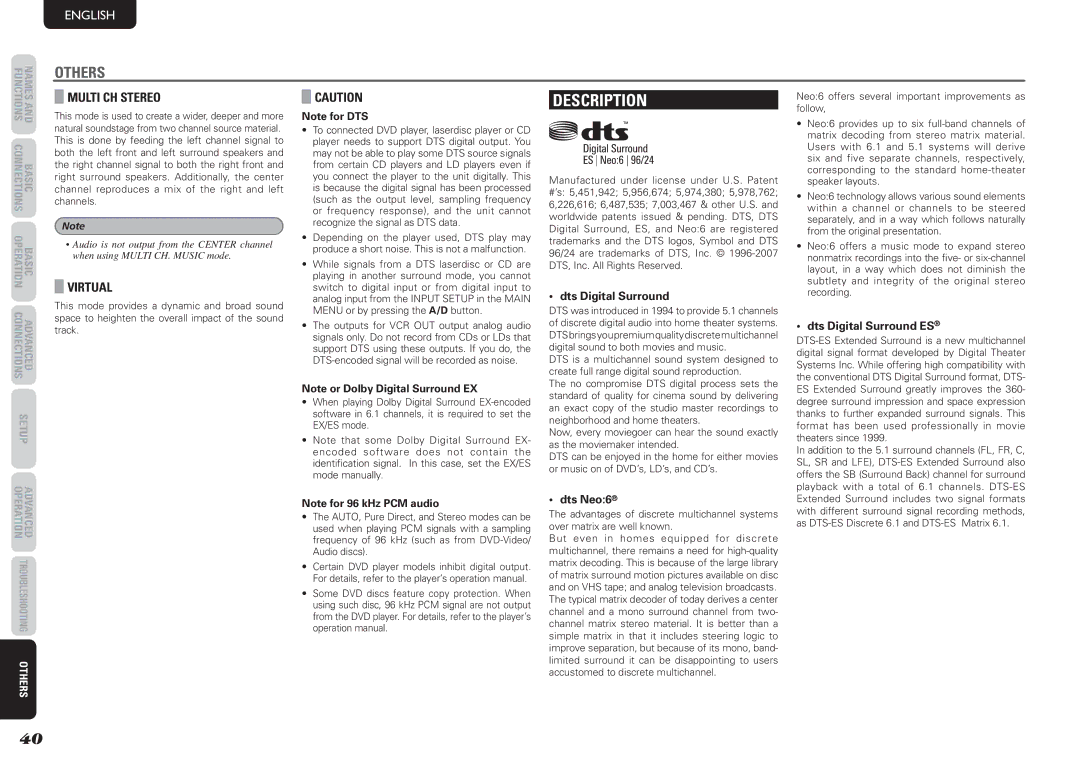
ENGLISH
FUNCTIONS | NAMES AND |
CONNECTIONS | BASIC |
OPERATION | BASIC |
CONNECTIONS | ADVANCED |
SETUP | |
OTHERS
MULTI CH STEREO
This mode is used to create a wider, deeper and more natural soundstage from two channel source material. This is done by feeding the left channel signal to both the left front and left surround speakers and the right channel signal to both the right front and right surround speakers. Additionally, the center channel reproduces a mix of the right and left channels.
Note
•Audio is not output from the CENTER channel when using MULTI CH. MUSIC mode.
VIRTUAL
This mode provides a dynamic and broad sound space to heighten the overall impact of the sound track.
CAUTION
Note for DTS
•To connected DVD player, laserdisc player or CD player needs to support DTS digital output. You may not be able to play some DTS source signals from certain CD players and LD players even if you connect the player to the unit digitally. This is because the digital signal has been processed (such as the output level, sampling frequency or frequency response), and the unit cannot recognize the signal as DTS data.
•Depending on the player used, DTS play may produce a short noise. This is not a malfunction.
•While signals from a DTS laserdisc or CD are playing in another surround mode, you cannot switch to digital input or from digital input to analog input from the INPUT SETUP in the MAIN MENU or by pressing the A/D button.
•The outputs for VCR OUT output analog audio signals only. Do not record from CDs or LDs that support DTS using these outputs. If you do, the
Note or Dolby Digital Surround EX
•When playing Dolby Digital Surround
•Note that some Dolby Digital Surround EX- encoded software does not contain the identification signal. In this case, set the EX/ES mode manually.
DESCRIPTION
Manufactured under license under U.S. Patent #’s: 5,451,942; 5,956,674; 5,974,380; 5,978,762; 6,226,616; 6,487,535; 7,003,467 & other U.S. and worldwide patents issued & pending. DTS, DTS Digital Surround, ES, and Neo:6 are registered trademarks and the DTS logos, Symbol and DTS 96/24 are trademarks of DTS, Inc. ©
• dts Digital Surround
DTS was introduced in 1994 to provide 5.1 channels of discrete digital audio into home theater systems. DTSbringsyoupremiumqualitydiscretemultichannel digital sound to both movies and music.
DTS is a multichannel sound system designed to create full range digital sound reproduction.
The no compromise DTS digital process sets the standard of quality for cinema sound by delivering an exact copy of the studio master recordings to neighborhood and home theaters.
Now, every moviegoer can hear the sound exactly as the moviemaker intended.
DTS can be enjoyed in the home for either movies or music on of DVD’s, LD’s, and CD’s.
Neo:6 offers several important improvements as follow,
•Neo:6 provides up to six
•Neo:6 technology allows various sound elements within a channel or channels to be steered separately, and in a way which follows naturally from the original presentation.
•Neo:6 offers a music mode to expand stereo nonmatrix recordings into the five- or
•dts Digital Surround ES®
In addition to the 5.1 surround channels (FL, FR, C, SL, SR and LFE),
ADVANCED OPERATION |
TROUBLESHOOTING |
OTHERS |
Note for 96 kHz PCM audio
•The AUTO, Pure Direct, and Stereo modes can be used when playing PCM signals with a sampling frequency of 96 kHz (such as from
•Certain DVD player models inhibit digital output. For details, refer to the player’s operation manual.
•Some DVD discs feature copy protection. When using such disc, 96 kHz PCM signal are not output from the DVD player. For details, refer to the player’s operation manual.
• dts Neo:6®
The advantages of discrete multichannel systems over matrix are well known.
But even in homes equipped for discrete multichannel, there remains a need for
Extended Surround includes two signal formats with different surround signal recording methods, as
40
